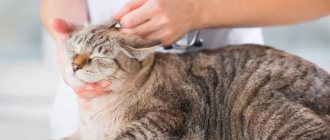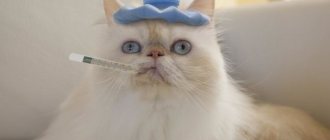A cat's normal body temperature is between 38 and 39 degrees (when measured rectally). A cat's body temperature is a comprehensive indicator of the body's thermal state. Cats are mammals, that is, they are warm-blooded, or homeothermic animals. This means that their body temperature normally fluctuates within very narrow limits, and any deviation beyond these limits (increase or decrease) will be a sign of various pathologies or adverse effects of the external environment. Body temperature is one of the most ancient ways of determining the current state of the body (the so-called biomarker).
What temperature should a cat be?
The most definitive way to tell if your cat has a fever is to take her temperature. A cat's normal body temperature is between 37.5 and 39.2 degrees Celsius. Temperatures above this range indicate fever
Ear thermometers are simpler and more convenient for pet owners, but as the Petcha website explains: “The best and most cost-effective way to take a cat's temperature is to use a pediatric rectal glass or digital thermometer. "Taking a cat's temperature at home requires two people: one to hold the cat and the other to insert the thermometer." Be sure to lubricate the thermometer with Vaseline and wait at least two minutes after inserting to get the most accurate result. Do not insert the rectal thermometer too deeply, as rectal tissue is sensitive and you may injure the animal. Also, never use a mercury thermometer because if it breaks, it can be very harmful to the cat's health and life.
While it's not the most attractive or convenient method, taking a rectal temperature is the best way to answer the question of whether your pet has a fever. If you are not comfortable doing this yourself, contact your veterinarian to have her temperature taken. It's also important to have your cat's vaccination records so your veterinarian can learn about any other diseases your pet may not have been vaccinated for to help narrow down the cause of her fever.
Temperature regulation mechanism
The thermoregulation center located in the hypothalamus (an area in the brain) is responsible for maintaining body temperature at a constant level. The temperature in the hypothalamus is determined by the so-called set point, and is perceived by the body as normal. The normal temperature for cats is 38-39 degrees. The hypothalamus compares its own temperature with information it receives from nerve receptors on the surface of the body. If it is the same, everything is fine. If the temperature from the surface of the body is higher than in the hypothalamus (for example, in hot weather), the thermoregulation center must lower it. To do this, mechanisms are used to increase the heat transfer of the body, and, accordingly, its cooling - the vessels approaching the skin expand, the blood cools faster. For a person, this would also manifest itself in increased sweating, but cats do not sweat, only some may have wet paw pads.
If the body surface temperature is lower than in the hypothalamus (respectively, in cold weather), the thermoregulation center increases it. In this case, a spasm (narrowing) of the superficial vessels occurs, the hair rises (a similar reflex remains in humans when the hairs on the skin stand on end from the cold), and the frequency of respiratory movements decreases. Cats take a position that allows them to minimize heat transfer (curl up into a ball).
Both processes described are natural, non-pathological, and occur when the ambient temperature changes. Changes are controlled by the autonomic nervous system.
For the body (and diagnostics), a pathological increase in temperature is of greatest importance.
Causes
If you believe your cat has a fever (or, to use the medical term, hyperthermia), your veterinarian will determine whether further testing is needed to determine the cause. Knowing the animal's medical history will be very helpful here. If you must see a different healthcare provider than one who already knows your pet, be sure to provide documentation of your pet's medical history, especially a list of medications, as cats sometimes have poor reactions to certain medications.
Just like in humans, there are many possible causes of fever in cats. The most common is a bacterial infection. Other likely causes are problems with the immune system or inflammation, exposure to toxins, a disorder or some kind of disease. It may be that the cause of your cat's fever cannot be determined, in which case you and your veterinarian can discuss next steps.
Why do you need to consult a doctor?
An increase in body temperature can indicate a variety of health problems, so it is very important to examine your cat and make the correct diagnosis. After a visual examination, if obvious causes are not established, the doctor may prescribe additional tests: ultrasound of the abdominal cavity, x-ray of internal organs, determination of hormone levels, urine, feces, blood tests, etc. In some cases, consultation with highly specialized specialists is required, for example, an allergist, neurologist, infectious disease specialist, gastroenterologist, oncologist.
At the same time, the doctor corrects the cat’s condition, if necessary, prescribes infusion therapy to replenish lost fluid, and administers antipyretic medications. In severe cases, the animal must be placed in a hospital to ensure constant monitoring, maintaining the functioning of the kidneys, lungs, heart and other internal organs.
Prolonged elevated body temperature poses a serious threat to the life of animals, so a visit to the veterinarian or calling him to your home should not be postponed. Correct diagnosis is very important so that treatment is not only symptomatic.
Therefore, it is fundamentally important to show the cat to a qualified specialist. "Bio-Vet" is a professional veterinary clinic. Our branches are located in all districts of Moscow, in Reutov and Lyubertsy. We have doctors of all specializations working around the clock who will quickly provide competent assistance.
Treatment
In addition to rest and drinking plenty of fluids, antibiotics are commonly used to treat fever in cats. Getting your cat to take medications, as well as taking his temperature, is not easy, but it is very important. If he spits out the pill or doesn't eat the cat food you hid it in, use these great tips on how to give pills to your pet. One of them is to wrap the animal in a towel for its comfort and safety. It would be nice to get an assistant to cope with this non-trivial task.
In some cases, your veterinarian may recommend a liquid medication for hyperthermia, which is easier to give.
It's not easy to watch your fur baby suffer from a fever, but beyond the medical care instructions your veterinarian has prescribed, there are some steps you can take to prevent the illness from developing. Regular cat care (brushing teeth, trimming nails) and periodic checkups (checking ears, monitoring her eating and drinking habits) will help lay an excellent foundation for a healthy life for your pet.
And don't forget to hug the cat. A little love will help your pet get better faster!
Caring for a cat with a fever
Cats that show signs of fever for more than 24 hours or a temperature above 40°C at any time should contact a veterinarian. Your veterinarian can perform tests to determine the source of the fever and take steps to treat the underlying problem.
For example, if the source of the infection is a bacterial infection, antibiotics may be needed. Moderate or severe dehydration is treated with intravenous or subcutaneous fluids.
Never give your cat medication without the advice of a veterinarian. Some fever medications, such as paracetamol, are toxic to cats.
Additional symptoms
Fever in pets is often accompanied by apathy, lack of activity and decreased appetite. The animal may even refuse water and spend most of its time lying on its side. At the same time, the cat often hides from its owner in a secluded place where no one will disturb it:
- If your pet additionally has diarrhea and vomiting, this may indicate food poisoning or acute gastrointestinal diseases: ulcers, pancreatitis and liver damage. In this case, tachycardia may also occur, the animal’s fur loses its shine and falls off.
When the temperature rises, the pet often experiences apathy and lack of appetite.
- If the pet does not allow you to touch its belly and reacts to any attempt with a plaintive meow or aggression, then this behavior indicates pathologies of the abdominal cavity.
- When the temperature rises, you need to examine your pet’s skin. In the presence of sores, wounds and rashes, tick-borne encephalitis, lichen or severe allergic reactions can be suspected.
If the animal refuses water, it is important to immediately consult a doctor, as dehydration can cause death. This is especially necessary if the fever is accompanied by diarrhea.
Symptomatic diet and procedures
If the temperature is high, then you can help your pet in the same way as a child. That is, apply cool, damp cloths to the main arteries (armpits, neck, inner thighs). Such procedures help well with banal overheating.
When the temperature rises, the animal should be given a lot to drink. Sometimes it is recommended to apply pieces of ice, but you need to be careful with this procedure.
If the temperature rises quickly and has reached high numbers, you should not apply ice. This may lead to seizures. In this case, the animal is prescribed special veterinary medications to reduce the temperature. In this case, the animal requires specific treatment.
In addition, it is worth remembering that a cat’s body becomes hypothermic just as quickly as it overheats. Therefore, you should not bathe your animal in a cold shower. You can't even pour cold water on it.
You can place your cat under a fan or air conditioner when his temperature is elevated. But again it is necessary to ensure that the pet does not become hypothermic.
An effective way is to use a weak vinegar solution. They lubricate the cat's pads about once an hour.
Echinacea tincture has also proven itself well. It is necessary to mix the tincture with water (at the rate of 1 drop per 1 kilogram of the cat’s weight) and give the pet this mixture.
A high body temperature in a cat is an unpleasant phenomenon, but there is no need to panic. It is necessary to observe the animal and try to reduce the temperature using folk methods. If the animal gets worse, it must be shown to a veterinarian.
First aid for high and low temperatures
If the animal has a high temperature, you can wrap it in a wet blanket, and if it has a low temperature, you can wrap it in a dry blanket.
An increase in a cat's temperature above 40ﹾC is serious, at which a large amount of fluid is lost from the animal's body, and at a temperature of 41ﹾC, the loss of fluid is critical, which can cause cerebral edema.
To provide first aid to an animal at a temperature of 40ﹾC and above, you must perform the following steps:
- Humidify the air in the room so that it is not hot and dry;
- Place an ice pack on the pet’s inner thighs and neck or wrap the cat in a towel or cloth soaked in cold water;
- Give the animal more cold water. If it is difficult for him to drink, add water using a pipette or syringe without a needle.
It is not allowed to give antipyretic drugs to an animal on your own, without a doctor’s recommendation.
At low temperatures it is necessary:
- Place the animal in a warm place;
- Wrap him in a blanket, blanket or dry towel;
- Provide warm water, and if you refuse to drink, pour in warm water with a pipette or syringe without a needle;
- Rub your paws;
- Place containers with warm water (bottles, heating pads) next to the cat.
How to determine body temperature
The answer is simple - measure with a thermometer. But if it is not at hand, you can determine poor health by indirect signs. These signs can be considered:
- lethargic state;
- inappropriate behavior;
- poor appetite;
- drinking plenty of water;
- frequent or too infrequent breathing.
But the usual sign, a wet and cool nose, does not always work. If your pet is excited, wants to eat or drink, or if the room is dry and hot, the nose may be dry and warm.
Heat stroke in a cat
Representatives of the cat family practically do not sweat in the heat. To feel more comfortable under the scorching sun, animals lick themselves more often, but this does not reduce the risk of heat stroke. There are few thermoreceptors on the skin of pets, so a short-term increase in temperature may go unnoticed.
Some types of cats are at risk of overheating more often than others - these are exotic breeds with a short muzzle, hairless and short-haired breeds, animals with cropped hair. Risk factors also include:
- being overweight;
- venerable age;
- chronic cardiovascular diseases, asthma, shortness of breath.
If your pet is initially at risk, do not forget to monitor its condition on hot days. Heatstroke in a cat that is regularly outdoors goes away more easily and quickly than in completely indoor pets. If an animal suffers from overheating, this will affect its well-being and behavior:
- the increase in temperature is noticeable to the touch;
- breathing quickens and becomes deeper;
- salivation increases;
- the nose becomes dry and hot;
- the mucous membranes on the gums turn pale or red;
- lethargy appears, stability of movements is lost;
- Possible nosebleeds.
If you notice some of these signs, you need to urgently take measures to alleviate the cat’s condition.
Signs of fever
At fever, the cat becomes lethargic and drowsy
Elevated temperature can be a consequence of various diseases, inflammatory processes or a reaction to infections. That is, the animal’s brain cells do not receive the required amount of oxygen.
The following symptoms may be external signs of elevated temperature:
- Weakness, lack of mood, drowsiness;
- Weakened appetite or lack thereof;
- The amount of fluid consumed is increased, the cat is thirsty and drinks often;
- Rapid breathing and heart rate;
- Hot and dry nose, hot ears and heated coat;
- Dilated pupils;
- The animal avoids people and activity, hides;
- Chills, fever, convulsions;
- Vomiting, loose stools;
- Pale tongue and mouth;
- The presence of foreign discharge from the eyes, nose or ears.
The presence of one or more signs gives cause for concern. But to make sure that the animal actually has a temperature, it is necessary to establish the exact temperature using special instruments. The presence of elevated temperature may indicate the presence of various viral, infectious and chronic diseases. But a low temperature is not the norm and cannot be ignored.











